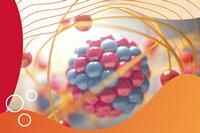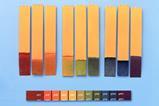Use these five tips to ensure learners have a strong understanding of atoms

Atoms are the smallest individual unit of matter. Everything around us is made up of atoms. The atomic model and atomic structure are the very foundation of our subject. As students move into the 14–16 stage of their studies, a good understanding of atomic structure helps underpin their understanding of many other important topics. So here are five tips for how to secure their understanding of atomic models.
1. Prevent model misconceptions
A common accusation of post-16 students is: ‘you lied to us at GCSE, there aren’t actually any electron shells’. Fundamentally, these learners haven’t properly understood the nature of models and how they are constructed at particular levels to explain phenomena. We explicitly teach the development of the atomic model up to the Bohr model, but nothing else is required at age 16.
It is important to make it clear to students that models continue to be refined and different models are useful at different times. As students develop in their understanding, so the models they use evolve and increase in complexity. Crucially, the atomic model, like many models in science, is not a model in the literal sense, like a toy car is a model version of a full-size car.
2. Challenge knowledge
It can be easy to spend a lot of time on relatively mundane procedural questions like calculating the numbers of subatomic particles. These are trivial for most students and only probe a surface level of understanding. Once students secure understanding of this stage, move on to more challenging questions that require applied knowledge and careful language.
Questions like ‘Explain why an atom of calcium is charge neutral’ and ‘Explain, with reference to the atomic model, why the relative atomic mass of chlorine is 35.5’ give greater insight into how well students understand the model and its implications.
3. Look for sequencing problems
Curriculum is a human endeavour, not simply a rigid set of objectives on a page. If you’re a member of the science leadership team and something isn’t working for your teachers and your student cohort, then it’s worth discussing how a change in the curriculum sequence might help students make better progress.
For many years at my school, we taught atomic structure in the accepted sequence, by teaching students to work out the numbers of subatomic particles, isotopes and relative atomic mass, followed by a different topic. However, in some whole-year group tests, we noticed that students couldn’t explain why an atom of calcium is charge neutral. The students should have had all the knowledge required to answer the question, but it occurred to us that they had never met anything other than a neutral atom and so hadn’t thought about overall charge as a consequence of the number of protons and electrons. Consequently, we changed our atomic structure teaching so it extended to ion formation and, in subsequent years, students answered these kinds of questions more successfully.
4. Make activities count
It is usually a good idea to help students understand models by progressing from abstract to concrete models. As such, you see a lot of teaching activities that involve making models of atoms with sweets, beads, counters or plasticine. These additional materials can make teaching more difficult, though, because they’re things to fiddle with, drop on the floor or eat.
If you’re choosing to do these sorts of activities, think carefully about your class, their needs and how you will manage the logistics. Sometimes, it will be worth the time spent and, other times, it won’t. It’s OK to leave behind activities that don’t work for you and your teaching style, and to embrace new ones.
3. Look for sequencing problems
Curriculum is a human endeavour, not simply a rigid set of objectives on a page. If you’re a member of the science leadership team and something isn’t working for your teachers and your student cohort, then it’s worth discussing how a change in the curriculum sequence might help students make better progress.
For many years at my school, we taught atomic structure in the accepted sequence, by teaching students to work out the numbers of subatomic particles, isotopes and relative atomic mass, followed by a different topic. However, in some whole-year group tests, we noticed that students couldn’t explain why an atom of calcium is charge neutral. The students should have had all the knowledge required to answer the question, but it occurred to us they had never met anything other than a neutral atom and so hadn’t thought about overall charge as a consequence of the number of protons and electrons. Consequently, we changed our atomic structure teaching so it extended to ion formation and, in subsequent years, students answered these kinds of questions more successfully.
4. Make activities count
It is usually a good idea to help students understand models by progressing from abstract to concrete models. As such, you see a lot of teaching activities that involve making models of atoms with sweets, beads, counters or plasticine. These additional materials can make teaching more difficult, though, because they’re things to fiddle with, drop on the floor and eat!
If you’re choosing to do these sorts of activities, think carefully about your class, their needs and how you will manage the logistics. Sometimes, it will be worth the time spent and, other times, it won’t. It’s OK to leave behind activities that don’t work for you and your teaching style, and to embrace new ones.
5. Check for understanding
Good knowledge of atomic structure is crucial for many topics in chemistry: patterns of reactivity, bonding and electrolysis are just a few examples. Check student understanding of the core concepts in atomic structure before teaching any of these topics, to prevent problems arising later.
Include quick questions on atomic structure in the starter and plenary of a lesson to activate prior knowledge. Tackle any lingering misconceptions before the more challenging concepts are taught.
Further reading
Find more teaching ideas, CPD and resources to support you in teaching atomic structure and planning your lessons:
- Discover how to build a solid understanding of atomic structure at 11–14.
- Check your 14–16 and 16–18 learners’ understanding of atomic structure with this starter for 10.
- Find out how teaching post-16 atomic models to 14–16 learners can help minimise misconceptions.
- Help your post-16 learners master atomic structure and periodicity with these teaching tips and resources.
- Looking for ideas on sequencing? Use these teaching tips for sequencing teaching ionic equations and practical work.
Kristy Turner















1 Reader's comment